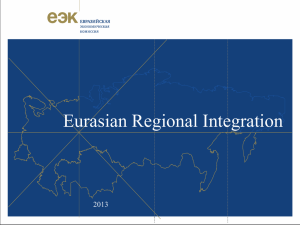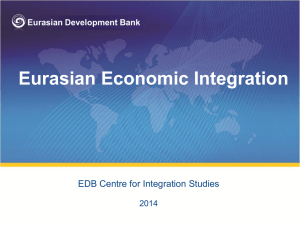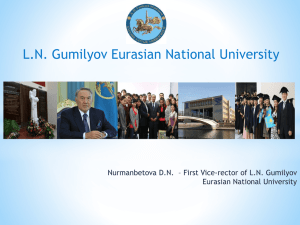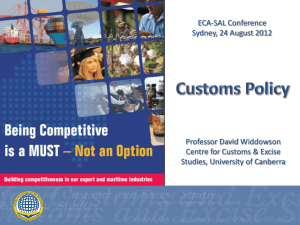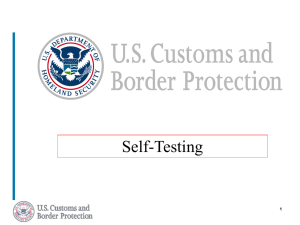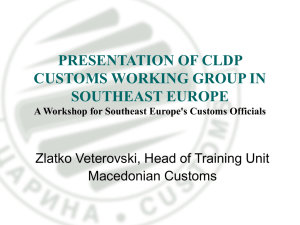the eurasian economic union (presentation)
advertisement
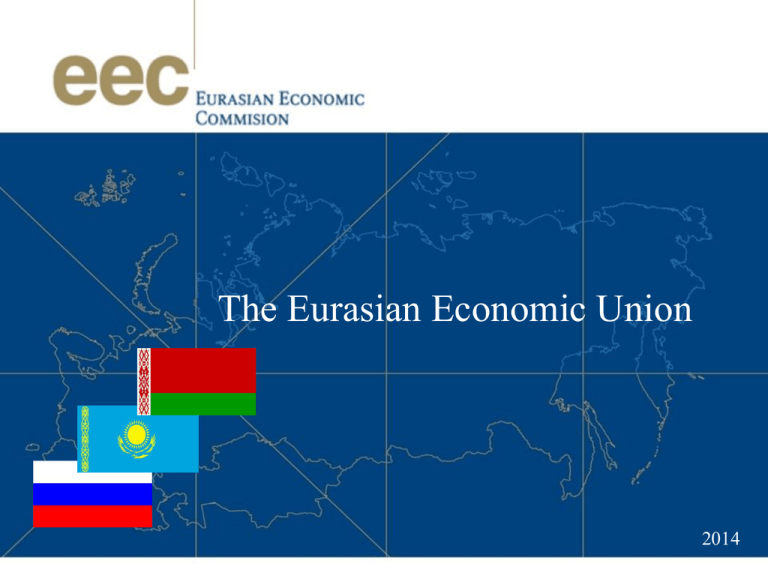
The Eurasian Economic Union 2014 Eurasian Economic Union: facts and figures • Population: 172,6 million people • Territory: more than 20 million square kilometres • Money income per capita: U.S. $ 8,857 • GDP: U.S. $ 2.389,2 billion | 2 Some socio-economic indicators of the CU and the SES functioning Mutual trade in goods 200 175 The volume of mutual trade reached $64.1 billion in 2013 150 125 100 2009 2013 | 3 Some socio-economic indicators of the CU and the SES functioning | 4 Structure of exports by commodity groups 2013 2010 74,1 70,4 10,0 10.1 12,9 14,3 38,0 Member States exports to the single market 33,0 16,5 Member States exports to the single market 20,4 5,2 10,5 4,8 10,6 12.8 10.9 10,6 7,4 2,8 2,3 8,7 2,6 Member States exports to the third countries 2,9 8,2 Food industry products and agricultural raw materials mineral products chemical products metals and articles thereof machinery equipment and vehicles other products Some socio-economic indicators of the CU and the SES functioning | 5 Employed and unemployed 85 2500 84.6 2240.7 84.5 2000 84 83.9 1657.5 1500 1350.8 83 1124.5 82.7 82 968.6 81.9 1000 500 81 0 2009 2010 2011 2012 Employed population, million persons занятые в экономике, млн. человек (левая (left ось) axis) безработные,зарегистрированные в службахservice, занятости населения, тыс. человек (правая ось) Unemployed registered by employment thousand persons (right axis) 2013 Some socio-economic indicators of the CU and the SES functioning | 6 The unemployment rate in selected countries and economic groups of countries (ILO methodology, in percent) 30 25 20 15 2009 2013 10 5 0 Spain Poland France USA United Kingdom Germany Japan Austria EU-28 CU and SES Some socio-economic indicators of the CU and the SES functioning | 7 Gross Domestic Product (in percent to 2009) 118 116.2 116 113.4 114 112 115.3 112.8 CU and SES ТС и ЕЭП 109.6 110 EU ЕС-28 109.3 108 Мир в целом 106 104 World 105.2 104.8 103.7 103.4 103.6 2012 2013 102.0 102 100 2009 2010 2011 Some socio-economic indicators of the CU and the SES functioning Gross Domestic Product per capita (U.S. $) 14000 12000 14,054 13,315 12,645 10000 10,247 8000 8 250 2,009 2,010 2,011 2,012 2,013 | 8 Some socio-economic indicators of the CU and the SES functioning | 9 Main economic indicators (in percent to 2009) 130 123.7 125 124.6 Промышленное производство industrial production 120 121.9 118.4 116.9 115 116.9 121.7 freight turnover (excluding Объем перевозок (без pipeline) трубопроводного транспорта) 117.3 113.2 110 fixed capital investments Инвестиции в основной капитал 107.7 106,3 105 106,0 100 2009 2010 2011 2012 2013 Dynamic of realization of the Eurasian integration project | 10 Launch of the Eurasian Economic Union (EEU) Treaty on the EEU Launch of the SES and the Eurasian Economic Commission Declaration of the Eurasian Economic Integration Treaty on the Eurasian Economic Commission Launch of the Customs Union 1994 1995 1996 1999 2000 2003 2007 … 2010 2011 2012 2014 1st January 2015 Treaty on the Commission of the CU Treaty on the establishment of the Common Customs Territory and the CU Formation Agreement on the SES Treaty on the establishment of the Eurasian Economic Community Treaty on the Customs Union and the Single Economic Space Agreement on deepening integration in the Economic and Humanitarian Fields Treaties on the Customs Union Lecture by the President of Kazakhstan Nursultan Nazarbayev on the Eurasian Union at the Moscow State University | 11 Stages of the Eurasian integration project The year 2015 Establishment of the Eurasian Economic Union - An economic union incorporated as an international legal body with its relevant institutions 2012 2010 Establishment of the Free Trade Area 1992-1999 – operates on the basis of bilateral and multilateral agreements 2011 – Treaty on the Free Trade Area within CIS Customs Union - Single customs code - Single customs tariff - Single customs territory - Single system of tariff and non-tariff regulation Establishment of the Single Economic Space - 17 framework agreements - Establishment of the Eurasian Economic Commission as a supranational body Structure of the Eurasian Economic Union Treaty Part I Part II Part IV 4 parts 28 sections 118 items 33 applications 1014 pages The Customs Union: Information interaction and statistics Trade policy The Customs Union’s functioning Technical regulation Regulation of the circulation of medicines and medical Sanitary, veterinary-sanitary and devices quarantine phyto-sanitary measures Customs regulation within the Union Consumer protection Part III Establishment of the Eurasian Economic Union: General provisions Basic principles, tasks, competence and Union’s rights Bodies of the Union Union’s budget | 12 The Single Economic Space: Energy Macroeconomic policy Transport Monetary policy Trade in services, establishment and implementation of Government (municipal) procurement Intellectual property investment activities Industry Regulation of financial markets Agro-industrial complex Taxes and Taxation Labour migration General principles and rules of competition Natural monopolies Transitional and Final Provisions: Registration at the UN Secretariat General and special transitional provisions Dispute resolution Social guarantees, privileges and immunities Entry of the Treaty into force Accession to the Union; Observer status The Treaty’s compatibility with other The working language of the CU, international international agreements agreements within the Union and the Commission's Amendments to the Treaty decisions Withdrawal from the Treaty Access to the information Part I Establishment of the Eurasian Economic Union | 13 The Eurasian Economic Union The Union is an international organisation of regional economic integration, incorporated as an international legal body. The freedom of movement of goods, services, capital and labour is ensured in the framework of the Union. Besides, the framework enables the execution of coordinated, coherent and common economic policy, established by the Treaty and international agreements within the Union. The Union shall have jurisdiction within the limits established by the Treaty and international agreements within the Union. The structure of regulatory bodies in the Eurasian Economic Union • Defines the strategy, direction and prospects for the formation and development of the Union • Takes decisions aimed at achieving the goals of the Union • Decisions – consensus • Provides the realisation and control over the fulfillment of the Eurasian Economic Union Treaty, international agreements within the framework of the Union and decisions of the Supreme Eurasian Economic Council • Decisions - consensus • Supranational regulatory body • Provides the conditions for the functioning and development of the Union, offers decisions in the field of economic integration within the Union’s framework The Supreme Eurasian Economic Council (SEEC) (Heads of State) | 14 The Court of the EEU (equal representation; 2 judges from Member State) The Intergovernmental Council (Heads of Government) The Eurasian Economic Commission The Board The Соuncil (equal representation; 9 Board Members (Ministers) (equal representation; one Deputy Prime Minister from Member State) Executive body of the Commission, decisions, directives and recommendations are adopted by a qualified majority (2/3 votes) In the framework of the SEEC’s competence, decisions are made by consensus General regulation of the integration process in the Union Overall management of the EEC Decisions-consensus The Court is the permanent judicial body of the Union The purpose of the Court is to ensure, in accordance with the provisions of the Statute, the uniform application of the Member States and bodies of the Union Treaty, international agreements in the framework of the Union, international treaties of the Union with a third party and the decisions of the Union The Eurasian Economic Commission | 15 SUPRANATIONAL INSTITUTION The Commission is a permanent regulatory body with supranational functions EQUAL REPRESENTATION OF THE PARTIES Each Member State of the Customs Union and the Single Economic Space is equally represented in the Council and the Board of the Eurasian Economic Commission COMPTETITION FOR EMPLOYEES Employees of the Eurasian Economic Commission are selected through an open competition between the citizens of Belarus, Kazakhstan and Russia ADVISORY COMMITTEES AS AN ADVISORY BODY To interact with independent experts, representatives of government and business, advisory committees have been created by the Parties, within which issues are examined prior to being placed under consideration for the Board of the Eurasian Economic Commission DISCUSSIONS WITH THE BUSINESS COMMUNITY Important issues affecting the interests of the business community of the three countries are considered under Business Dialogue (Memorandum of Cooperation between the Eurasian Economic Commission and the Belarus-Kazakhstan-Russia Business Dialogue on June 15, 2012) Free movement of goods The goal - to create a single market for goods A single market is functioning, though with the following exemptions: Market for pharmaceuticals (exemption until 2016) Alcohol and tobacco products identification of areas of the harmonisation of legislation concerning excise rates (for the most sensitive of excisable goods) Market for electro-energetics (exemption until 2019) | 16 Markets for oil, gas and petroleum products (exemption until 2025) Motor vehicles free circulation of motor vehicles produced in the territory of the Member States as defined by the concept of "industrial assembly", where the level of localisation of production is not less than 50% from July 1, 2018 (before this time not less than 30%). Exception: free circulation within the territory of the Russian Federation of motor vehicles produced in the territory of Belarus, at the level of localization of production of less than 30% until January 1, 2017 in the amount established by the quota, after January 1, 2017 - on the general conditions set. Part II The Customs Union | 17 The Customs Union The Goal - functioning of the Customs Union without exemptions and limitations after the transition period. The Customs Union - a form of trade and economic integration of Member-States, that creates a unified customs territory, within which customs duties (other duties, taxes and charges having equivalent effect), non-tariff measures, safeguards, antidumping and countervailing measures do not apply in mutual trade. The CU has a common customs tariff set by the Eurasian Economic Union as well as the common trade policy towards any third party. Part II The Customs Union | 18 Functioning of the Customs Union Within the Union, a single customs union regulation is operating in accordance with the Customs Code of the Eurasian Economic Union. Trade with third parties is regulated through common measures, including through the Common Customs Tariff of the Eurasian Economic Union. Member States do not apply import and export customs duties (other duties, taxes and charges having equivalent effects), non-tariff measures, safeguards, antidumping and countervailing measures as part of the functioning of the internal market in the mutual trade in goods. The Customs Union There is a single market for goods for all the Member States, which means free movement of goods between the territories of the Member States without customs declaration and other border control measures (e.g. sanitary, veterinary, phytosanitary control). Part II The Customs Union | 19 Trade policy Trade Policy of the Union aims to promote the sustainable economic development of Member States, economic diversification, innovative development, increasing the volume and improving the structure of trade and investment, accelerating the integration process, as well as further development of the Union as an effective and competitive organisation in the global economy. The Commission assists in accessing the markets of third parties, monitors the restrictive measures of a third party in respect to Member States, and in the case of any action by a third party in respect of the Union or in case of a trade dispute between the Union and a third party in conjunction with the Member States, shall hold consultations with the corresponding third party in order to resolve the issue. The Union may apply joint measures to promote exports of Member States into third party markets, in accordance with international treaties, norms and rules of the World Trade Organization, including conducting negotiations and establishing free trade areas. Joint measures include, in particular, insurance and export credits, international leasing, promoting the concept of "product of the Eurasian Economic Union" and the introduction of a single labeling of the Union, organisation of fairs and expositions, advertising and branding activities abroad. Тhe Customs Union Trade Policy is implemented by the Union independently or jointly with the Member States, in the areas in which the bodies of the Union take binding decisions on the Member States, through the signing of international agreements with third parties, participation in international organisations or through independent applications of the measures and mechanisms of Foreign Trade Policy. Part II The Customs Union | 20 Customs and tariff regulation and non-tariff regulation The Union applies single commodity nomenclature of foreign economic activity of the Eurasian Economic Union and the Common Customs Tariff of the Eurasian Economic Union, which are approved by the Commission. A State which has acceded to the Union, as an exemption has the right to temporarily apply import duties that are different from the common customs tariff rate of the Eurasian Economic Union in accordance with the list of goods and rates approved by the Commission pursuant to an international treaty of accession of that State to the Union. The following common non-tariff measures are applied in trade with third countries by the Union: 1) the prohibition of import and (or) export of goods; 2) quantitative restrictions on the import and (or) export of goods; 3) the exclusive right to export and (or) import goods; 4) automatic licensing (observation) of export and (or) import of goods; 5) The authorisation procedure for import and (or) export of goods The Customs Union Import duty rates of the Common Customs Tariff of the Eurasian Economic Union are uniform and not subject to change depending on persons transporting goods across the customs border of the Union, the types of transactions and other circumstances. (except as defined by the Contract) Part II The Customs Union | 21 Technical regulation Technical regulation is the basis of the safety of products throughout their life cycle. Mandatory safety requirements apply only to the products included in the Uniform list, which currently consists of 66 products. 34 technical regulations adopted 28 technical regulations entered into force 6 technical regulations will enter into force in 2014-2015 Sanitary, veterinary and quarantine phytosanitary measures (SPS) Sanitary, veterinary and quarantine phytosanitary measures applied on the scientific basis, and only to the extent that is necessary to protect the life and health of humans, animals and plants. Application of SPS measures is aimed at ensuring the sanitary-epidemiological, veterinary and quarantine phytosanitary safety of the territory of the Eurasian Economic Union. The Customs Union Technical regulations of the Union have direct effect in the territory of the Member States and apply in the Member States without exemptions, which ensures free movement of products within the Union. Standards necessary to fulfill the requirements of technical regulations apply on a voluntary basis. Part II The Customs Union | 22 Consumer protection Citizens of a Member State, as well as other persons living on its territory, enjoy in the territories of other Member States the same legal protection in the field of consumer protection as citizens of other Member States, and shall have the right to apply to state and local organizations for consumer protection, and other organizations, as well as courts and (or) exercise other procedural actions on the same conditions as the nationals of other Member States Information interaction in the framework of the EAEU An integrated information system of the Union shall be created, which will integrate geographically distributed state information resources and authorized bodies’ information systems, as well as information resources and information systems of the Commission Official statistics of the EAEU For effective functioning and development of the Union, official statistical information is being formed The Customs Union Pursue a coordinated policy in the field of consumer protection, aimed at creating equal conditions for citizens to protect their interests from unfair activities of economic entities Part III The Single Economic Space | 23 The Single Economic Space The Goal - The intention is to create a single market for goods, services, capital and labour within the Union - Comprehensive modernisation, cooperation and competitiveness of national economies into the global economy The Single Economic Space - Space consisting of the territories of the Member States, where similar (comparable) and uniform mechanisms operate to regulate the economy based on market principles and application of harmonised or unified legal norms, and a single infrastructure. Coordinated and common policies | 24 Coordinated transport policy Coordinated competitive (antimonopoly) policy Coordinated exchange-rate policy Coordinated regulation of financial markets Coordinated macroeconomic policies Common customs regulation Common customs tariff and non-tariff regulation Common measures regulating trade in goods with third parties Coordinated policy in the field of application of sanitary, veterinary and sanitary and phytosanitary quarantine measures Coordinated policy in the field of measurement uniformity Coordinated policy in the field of consumer protection Coordinated policy in the energy sector Coordinated policy in the field of information technology The Single Economic Space Coordinated agricultural Policy Part III The Single Economic Space | 25 Trade in services, establishment and implementation of investment activities Member States shall endeavor to establish and operate a single market for services. Liberalisation of trade in services, facilities, activities and investments is carried out in accordance with international principles and standards by harmonising the legislation of the Member States and the organisation of mutual administrative cooperation between the competent authorities of the Member States. The Single Economic Space Member States shall carry out a gradual liberalisation of trade in services, mutual conditions, institutions, activities and investments, to ensure freedom of trade in services, facilities, activities and investments. Free movement of services | 26 The Goal - to create a single market for services III basket: National treatment is not provided but the service from the basket can go to the first or second basket should the parties decide. II basket: Services transported to the first basket, after the liberalisation plan IV basket: prohibition on the delivery and receipt of services between members EAEU (The list attached in the treaty of EAEU) The Single Economic Space I basket: Delivery and receipt of services with the recognition of national licenses and without additional institutions ( from 2015) Free movement of capital | 27 The Goal - to create a single market of capital Creation of a supranational authority to regulate the financial market Most favoured nation treatment (exemption by individual national lists) The Single Economic Space The coordination of the exchange rate policy will be carried out by a separate body, which is composed of the heads of national (central) banks in the Member States, and the order of activity is determined by an international treaty within the Union Part III The Single Economic Space | 28 Macroeconomic policy Member States conduct economic policy within the following quantitative values of macroeconomic indicators in determining the sustainability of economic development: - annual deficit of the consolidated general government budget - does not exceed 3 percent of gross domestic product; - general government debt - does not exceed 50 percent of gross domestic product; - inflation (CPI) on an annualised basis (December to December of the previous year, in percent) does not exceed by more than 5 percentage points of inflation in the Member State in which this index has the smallest value. The Single Economic Space A coordinated macroeconomic policy is pursued within the Union, including the development and implementation of joint action by Member States in order to achieve a balanced economic development in the Member States Part III The Single Economic Space | 29 Exchange rate policy Coordination of exchange rate policy by a separate body, which is composed of the heads of national (central) banks of the Member States and the order of activity is determined by an international treaty within the Union. Each Member State provides admission to its domestic currency market for banks which are residents of Member States and have, in accordance with the laws of that Member State, the right to conduct foreign exchange operations, for interbank foreign exchange operations on the conditions for granting national treatment. The Single Economic Space Member States with the aim of deepening economic integration, developing cooperation in the monetary sphere, ensuring the free movement of goods, services and capital in the territories of the Member States, enhancing the role of the national currencies of the Member States in trade and investment operations, as well as providing mutual convertibility of these Rates, develop and implement a coordinated monetary policy. Part III The Single Economic Space | 30 Regulation of financial markets Member States within the Union carry out coordinated regulation of financial markets Member States after the completion of the harmonisation of legislation in the field of financial markets will decide on the powers and functions of a supranational authority to regulate financial markets and will create it with the location in the city of Almaty in 2025 The Single Economic Space Member States will execute a harmonisation of its legislation in the field of financial markets by 2025 Part III The Single Economic Space | 31 Taxes and Taxation Goods imported from the territory of one Member State to the territory of another Member State, are subject to indirect taxes. Stipulated: 1) harmonisation (convergence) of excise rates on the most sensitive of excisable goods; 2) further improvement of the system of levying value added tax in mutual trade (including the use of information technology). If a Member State, in accordance with its laws and the provisions of international agreements shall be entitled to tax the income of the resident of another Member State in connection with an employment exercised in the first-mentioned Member State, such income is taxed in the first Member State on the first day of employment at the tax rates provided for such individuals' income - tax residents (individuals resident) of the first Member State. The Single Economic Space Member States in mutual trade levy taxes, and other fees and charges so that the taxation in the Member State on whose territory the sale of other Member States’ goods is carried out, would be no less favourable than the taxation applied by that Member State in the same circumstances in respect to similar goods originating from its territory. Part III The Single Economic Space | 32 General principles and rules of competition Member States shall conduct a coordinated competition (antimonopoly) policy in respect to actions of economic entities (market actors) of third countries, if such actions could have a negative impact on competition in product markets of the Member States The Single Economic Space Commission: Considers applications (materials) for evidence of violation of the general rules on competition laid down in Article 76 of the Treaty, which has or may have an adverse effect on competition in cross-border markets, as well as conducting the necessary investigations; Initiates and examines cases of violation of the general rules on competition laid down in Article 76 of the Treaty, which has or may have an adverse effect on competition in cross-border markets, based on appeals of competent authorities of the Member States, business entities (market actors) Member States, authorities of the Member States, individuals or on their own initiative; Makes a determination, takes binding economic agents (market participants) Member States solutions, including the application of penalties to economic agents (market actors) of Member States, in the cases provided for in Section XVIII of the Treaty and this Protocol, to carry out actions aimed at ending violations of general rules of competition, elimination of the consequences of their violation, ensuring competition on the avoidance of actions that may be an obstacle for the emergence of competition and (or) can lead to restriction or elimination of competition on the transboundary market and violation of common rules of competition in cases under Section XVIII of the Treaty and this Protocol; Requests and receives information from public authorities, local authorities, other bodies or organizations of the Member States exercising their functions, legal entities and individuals, including confidential information, necessary for the exercise of authority to monitor compliance with the general rules of competition in crossborder markets. Sends annually, not later than June 1, to the Supreme Council, the annual report on the state of competition in cross-border markets and the measures taken to curb violations of common competition rules to them, and places an approved report on the official website of the Union on the Internet; Uploads decisions on matters considered inappropriate general competition rules on the official website of the Union on the Internet Part III The Single Economic Space | 33 Natural monopolies Expansion of natural monopolies in the Member States is carried out: - in accordance with the laws of the Member States, if a Member State intends to refer to the sphere of natural monopolies, which is the sphere of natural monopolies in another Member State and is given in Appendix number 1 or number 2 of Annex 20 to this Agreement; - determined by the Commission in case of natural monopolies to a Member State intends to carry another sphere of natural monopolies, not specified in Annex number 1 or number 2 of Annex 20 hereto, after appropriate treatment of the Member States to the Commission. The Single Economic Space Member States shall endeavor to harmonise the spheres of natural monopolies, the number listed in Annexes 1 and 2 to the application number 20 hereto, by their reduction and to determine the transition sections XX and XXI of the Treaty. Part III The Single Economic Space | 34 Government (municipal) procurement The Single Economic Space Member States shall determine the following objectives and principles of regulation in the state (municipal) procurement (hereinafter - Procurement) - ensure optimal and efficient expenditure of funds used for procurement in the Member States; - providing Member States national treatment in procurement; - inadmissibility to third countries in the field of procurement regime more favourable than that provided by the Member States; - ensure openness and transparency of procurement; - unhindered access for potential suppliers and providers of Member States to participate in the procurement conducted electronically through the mutual recognition of an electronic signature, made in accordance with the legislation of a Member State, another Member State; - Development of competition and anti-corruption and other abuses in procurement. Part III The Single Economic Space | 35 Energy Sector On completion of the programme of activities to form a common market for gas, oil and petroleum of the Union, Member States will conclude an international agreement within the Union on the formation of a common market of gas, oil and petroleum Union comprising common rules for access to gas transportation systems, oil and petroleum products transportation systems located in the territories of Member States, and ensure its entry into force no later than January 1, 2025 The Single Economic Space On completion of the programme of activities forming a common energy market of the Union, Member States will conclude an international agreement within the Union on the formation of a common energy market of the Union, including having common rules for access to the services of natural monopolies in the electricity sector and ensure its entry into force no later than July 1, 2019 Part III The Single Economic Space | 36 Transport The main priorities of a coordinated (coherent) transport policy are: 1) forming a single transport space; 2) establishment and development of Eurasian transport corridors; 3) implementation and development of transit potential within the Union; 4) coordinated development of transport infrastructure; 5) establishment of logistics centres and transport organisations providing transportation process optimisation; 6) involvement and use of human resources capacity of the Member States; 7) the development of science and innovation in the field of transport. The Single Economic Space A coordinated (harmonised) transport policy is being carried out in the Union, aimed at ensuring economic integration, consistent and gradual formation of a single transport space on the principles of competition, openness, security, reliability, availability and ecology Part III The Single Economic Space | 37 Intellectual property Member States shall register the trademark of the Eurasian Economic Union and service mark of the Eurasian Economic Union (hereinafter - the Trademark of the Union). The Union’s trademarks are granted legal protection in all of the territories of all Member States simultaneously. The Single Economic Space Persons of one Member State in the territory of another Member State are granted national treatment in regard to the legal regime of intellectual property. Legislation of a Member State may provide for exceptions to national treatment in respect to legal and administrative procedures, including an indication of an address for correspondence and the appointment of a representative. Part III The Single Economic Space | 38 Industry The Commission monitors the implementation of the provisions of this Article and the application number 28 to this Agreement and shall have the following powers: - decision of whether or not specific subsidies in accordance with paragraph 6 of Annex 28 to the Treaty based on the criteria defined by an international treaty within the Union provided for in paragraph 7 of Annex 28 to the Treaty; - a hearing on the facts of the specific provision of subsidies and adoption of binding decisions against them in the cases specified by an international treaty within the Union provided for in paragraph 7 of Annex 28 to the Treaty; - resolution of disagreements on matters relating to the implementation of the provisions of this Article and the application number 28 to this Agreement, and to provide explanations for their application If a Member State, for a specific subsidy, establishes the requirement for recipient (producer) the need for technological operations in the production of certain goods, the implementation of the manufacturer of another Member State of such operations in other Member States is recognised with proper execution of such requirements in accordance with the order determined by the Supreme Council. The Single Economic Space Member States develop the principal directions of industrial cooperation within the Union (hereinafter - Principal Directions), approved by the Intergovernmental Council and including the prioritised economic activities for industrial cooperation and sensitive items. Commission meets annually for monitoring and analysis of implementation of the Principal Directions and, if necessary, prepares in consultation with Member States proposals for the refinement of the Principal Directions. Part III The Single Economic Space | 39 Agro-industrial complex In order to ensure the development of agriculture and rural areas in the interests of the population of each Member State and the Union as a whole, as well as economic integration within the Union, an agreed (coordinated) agricultural policy is conducted, including assuming the use of regulatory mechanisms provided in this Treaty and other international agreements within the Union in the field of agriculture, the mutual granting by Member States to each other and to the Commission, of plans (programmes) of the development of production for each of the sensitive agricultural products, the list of which is formed on the basis of proposals by Member States and approved by the Commission. When conducting coordinated agricultural policy, Member States take into account the special nature on agriculture, not only due to the production, economic, but also social significance industry, structural and climatic differences between regions and territories of the Member States. The Single Economic Space To implement the agreed measures (coordinated) of agricultural policy, regular consultations of Member States are organised by the Commission, including on sensitive agricultural products, at least once a year. Part III The Single Economic Space | 40 Labour migration Education documents issued by educational organisations (educational institutions and organisations in education) of Member States, without the legislation of the state of employment procedures for the recognition of documents on education, are recognised in the State of employment in order to implement employment by the labour power of the Member States. Labour power of a Member State, applying for educational, legal, medical or pharmaceutical activities in another Member State, are established by the legislation of the State of employment procedure for the recognition of documents on education and may be admitted to teaching, legal, medical or pharmaceutical activities in accordance with laws of the State of employment. Citizens of a Member State, who arrived with the aim of implementing themselves in employment or employment in the territory of another Member State, and their family members are exempt from the obligation to register (for registration) within 30 days from the date of entry. Documents confirming academic degrees and academic titles issued by the authorised bodies of the Member States are recognised in accordance with the laws of the State of employment. The Single Economic Space Employers and (or) customers of works (services) of a Member State are entitled to engage in the implementation of employment of labour power of the Member States without restrictions for the protection of the national labour market. At the same time the workers of the Member States do not require a permit for carrying out work in the State of employment. Free movement of labour Non-discriminatory access to the labour market for citizens of the Union The Goal - to create a single labour market Exemption from compulsory registration within 30 days 2015 Length of service shall be Free medical care in included in the overall length of emergency and urgent form service for the purposes of insurance The Single Economic Space Mutual recognition of university diplomas without additional procedures | 41 Development dynamics of the Single Economic Space | 42 Freedom of movement of goods 100% 2025 Single Market for gas, oil and petroleum products 2019 Single electroenergetics market 2016 2015 Single market for pharmaceuticals and medical devices Single market for services within the second sectoral basket Freedom of capital movement 100% 2025 100% 2015 2015 2025 Creation of a supranational authority to regulate financial markets Freedom of movement of services Single market for services within the first sectoral basket 100% 2015 г. Freedom of movement of labor Overall labour market recognition of university diplomas Part IV Transitional and Final Provisions Union membership is open to any state that shares its aims and principles, on terms agreed by Member States Any State may contact the Chairman of the Supreme Council with a request for the status of an observer State of the Union The official language of the Union is Russian | 43 Bodies of the Union provide preliminary publication of the draft decisions on the official website of the Union on the Internet, at least 30 calendar days before the date on which the judgment is scheduled for adoption. Draft decisions of the Union taken in exceptional cases requiring a rapid response may be published on other dates This Agreement shall not prevent Member States from concluding international agreements, that are not contrary to the purposes and principles of this Treaty In accordance with Article 102 of the Charter of the United Nations this Treaty shall be registered with the Secretariat of the United Nations Date of publication of the Union’s body decision on the official website of the Union on the Internet is recognised as a formal publication of the decision Persons concerned may submit to the authority of the Union comments and suggestions to the draft The prospect of enlargement of the Eurasian Economic Union September 3, 2013 Statement by the President of the Republic of Armenia Serzh Sargsyan on the intention to join the Eurasian project November 6, 2013 Memorandum on deepening cooperation between the Eurasian Economic Commission and the Republic of Armenia December 24, 2013 The decision of the Supreme Eurasian Economic Council # 56 Adoption of the Roadmap for the Republic of Armenia's accession to the Customs Union and the Single Economic Space May 29, 2014 The decision of the Supreme Eurasian Economic Council #71 on the Treaty of Accession of the Republic of Armenia to the Treaty on the Eurasian Economic Union. | 44 March 12, 2011 Statement of intention of the Kyrgyz Republic to join the Customs Union May 31, 2013 Memorandum on deepening cooperation between the Eurasian Economic Commission and the Kyrgyz Republic May 29, 2014 The decision of the Supreme Eurasian Economic Council # 74 Adoption of the Roadmap of the Kyrgyz Republic's accession to the CU May 29, 2014 Statement of the Presidents of the Republic of Belarus, Kazakhstan, the Russian Federation and the Kyrgyz Republic to support the Kyrgyz Republic on accession to the Single Economic Space and the Eurasian Economic Union. The Eurasian Economic Union The Eurasian Economic Union Establishment of the single market for goods, services, capital and labor Harmonisation of legislation Development of integrated infrastructure Coordinated and common policies in the sectors of the economy Establishment of the institutional framework of the Union | 45

